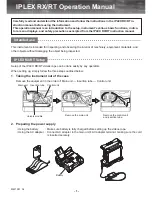
Page
1
of
2
Certified Control Rods
Part Number: ATP-4001 Contents: One Certified Positive Rod;
One Certified Negative Rod for verifying accuracy of Hygiena
SystemSure Plus and EnSURE instruments.
Description/Intended Use
Certified Control rods in this kit are intended to be used to verify calibration of the above mentioned luminometers. Positive Rod consists of C
14
radioactive source
that emits very low level of low-energy ß radiation in a plastic scintillation matrix. Matrix is configured to give constant light output, within 10% of its certified value
for up to 1 year.. Negative Rod is used to check for possible background light getting into instrument or light detector not calibrating correctly. The Certified
Negative Rod produces low light 0 RLU background. It is recommended to verify calibration with Certified Control Kit daily or as per instruction set out in your
Quality Control Program requirements. Incorporating Certified Control Rods into overall Quality Control program will validate instrument is within specifications
and operating correctly.
Certified Life: 1
year as marked on certificate.
Storage: Store at 15°-25°C (59°-77°F) in box rods were received in or dark container. Store away from light, heat and chemicals.
Directions for Use:
Positive and Negative Rods are inserted and read in luminometer in the same manner as ATP sample device. Certified
Control Rods
do not
need to be activated like the ATP sample device.
Do not
attempt to activate Positive or Negative
Rod.
1.
Open sample chamber and insert Positive Rod.
2.
Match up black line with fin next to opening and insert (see reverse page)
3.
Close lid. Let it sit for 1 minute.
4.
Press “OK” and take reading as normal.
5.
Record result. Repeat steps 1-4 several time to verify meter stability.
6.
Repeat steps using Negative Rod.
Interpreting Positive and Negative Control Results
Certified Positive Rod in a correctly calibrated SystemSURE Plus/Ensure luminometer should read within 10% of the value stated on your certificate. If the results
from the Positive Rod are outside the RLU range then the machine should be sent in for service. Negative Rod should read 0 RLU.
Incorporating the Calibration Control Kit into a Quality Control Program
Certified Control Rods are designed to be incorporated into a Quality Control Program that monitors and tracks performance of Hygiena equipment and/or devices.
When using calibration control rods to verify measurability of a luminometer; it is recommended that a specific program point (e.g. PROG 250) be assigned for
results. All results can be viewed directly from luminometer or in the data analysis software.
Causes for Inconsistent Calibration RLU Readings
Several factors can cause RLU readings to be outside acceptable range. Possible causes are:
•
Dirty or damaged calibration rods.
Clean outside of both rods with lint-free cloth that has been dipped in reagent-grade isopropyl or ethyl
alcohol. Air dry and repeat reading. Return damaged calibration rods to Hygiena for replacement.
•
Luminometer contamination.
Results that have changed suddenly, especially immediately after a number of sampling devices have been
run, can indicate contamination problems. Results from calibration rods can increase or decrease as result of foreign materials disturbing
optics chamber of instrument. If
contamination is suspected in the luminometer, remove read chamber and clean. See owner’s manuals on
how
to clean read chamber.
•
Scratches on glass bottom do not affect readings.
•
Exposure to light.
Inconsistent readings arise if calibration rods are exposed to intense light prior to being read. Insert calibration rods into a
luminometer and wait minimum of 2 minutes before taking reading.
•
Electrostatic charge buildup-
ground yourself and meter to a nearby tap.
Handling and Disposal
To ensure stability and longevity of calibration rods, take the following steps:
•
Limit exposure to light.
Store calibration rods in dark or weak ambient light. Kit box provided is recommended as appropriate dark storage. Do
not expose to direct sunlight or intense artificial light for too long before use.
•
Handle with care.
Avoid crushing, cutting, or dropping calibration rods. Any damage that changes shape or light transmission properties of the
Positive Rod can affect assigned values.
•
Disposal.
For U.S. and Canadian customers: Level of radioactive material in Positive Rod does not require special hazardous waste treatment, per
U.S. Federal regulations governing use and transfer of exempted radioactive materials. The contents of the Positive Rod are exempt from NRC or
Agreement State licensing requirements. Positive Rod contains extremely small amounts of radioactive carbon-14, completely contained by the
outer housing of the device. There are no radioactive emissions on the surface of the device, and no special precautions are needed in handling
the device to avoid exposure. Positive Rod is designed for use and storage at room temperature; prolonged exposure to extreme heat or cold
should be avoided. Do not use if the scintillator tip of the device is cracked or damaged.
•
To dispose of Positive Rod, remove or deface
“Caution Radioactive Materials” label on rod.
Positive Rod may then be disposed of in trash.
For disposal requirements in other countries, check with your national and local supplier. For questions, contact Scigiene.
•
Radioactive Material
–
Not for Human Use
–
Introduction into foods, beverages, cosmetics, drugs, or medicinal products, or into products
manufactured for commercial distribution is prohibited. Exempt quantities should not be combined.
Summary of Contents for ATP-4001
Page 2: ...Page 2 of 2 ...




















